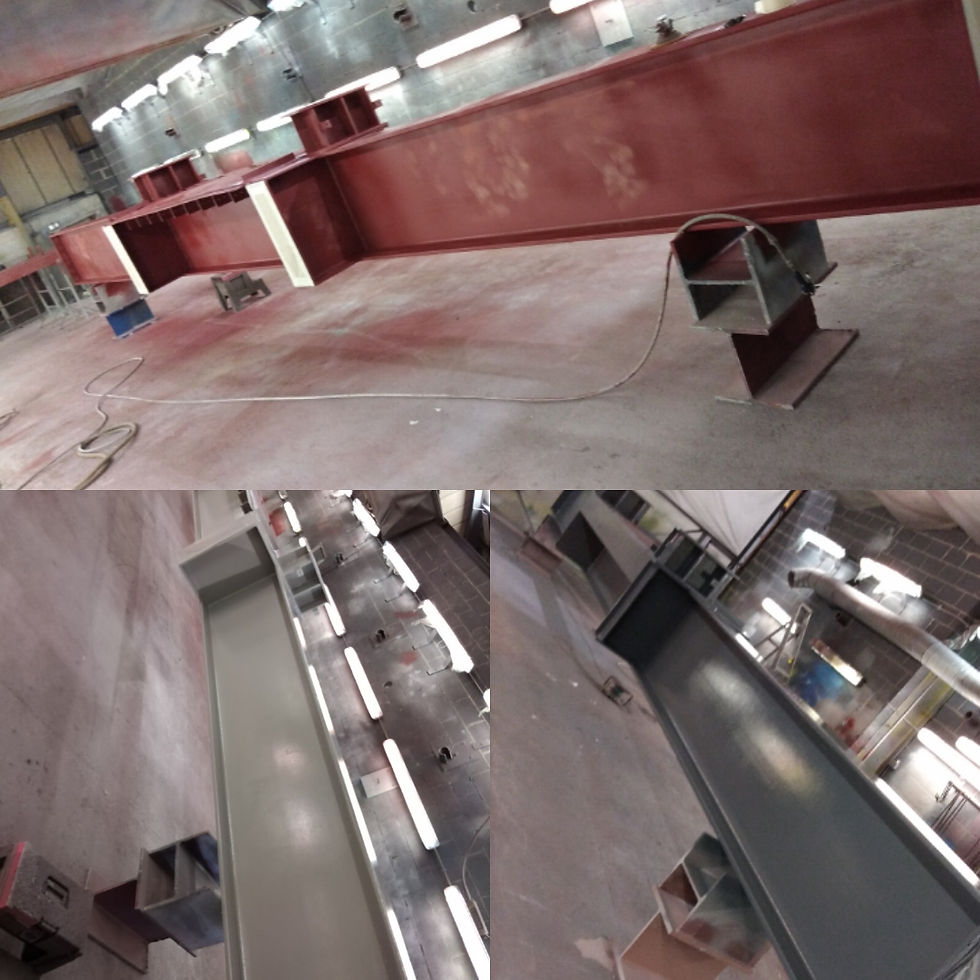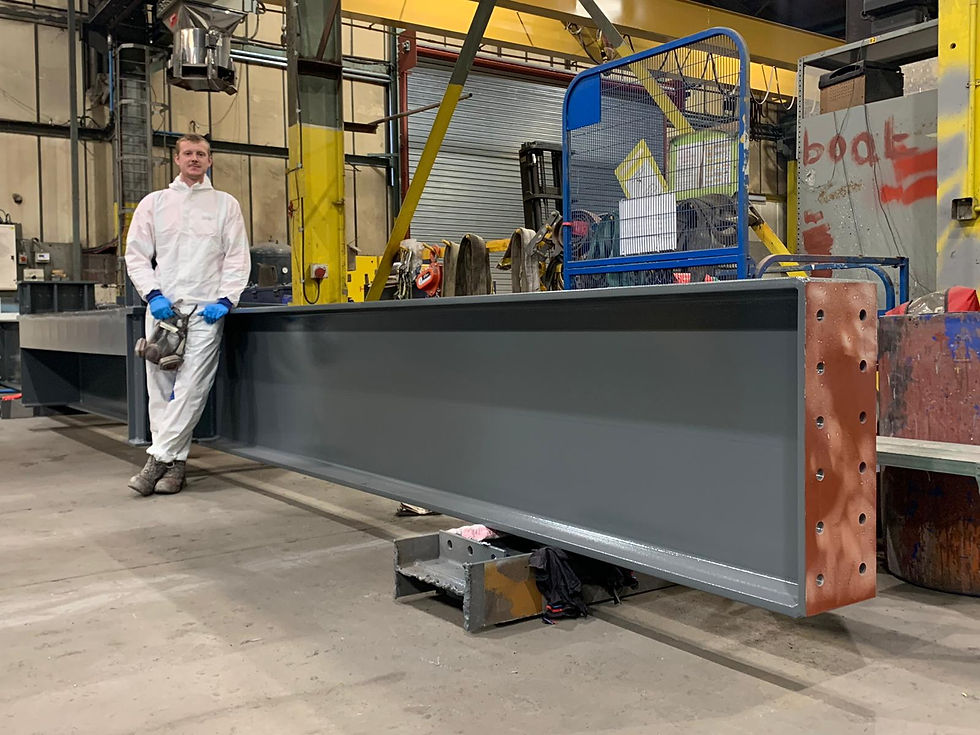A Guide To The Industrial Painting & Coating Process
- Universal Coatings
- Jun 26, 2020
- 4 min read
For this guide we will show an example of some recent works carried out on parts of a railway station lift shaft, exceeding 9 metres long this linking beam was handled throughout our workshop with our pair of overhead cranes working in tandem to ensure it was manoeuvred safely through the necessary stages of production in their respective work bays.

As this steel beam was part of a Network rail project it needed to meet strict requirements of various specifications throughout the preparation and coating process.
Stage 1: Surface Preparation
Blast cleaning to SA3 Specification

Commonly known as sandblasting, blast cleaning is a process of stripping back imperfections, corrosion and scale from metals to create a smooth and treatable surface with high adhesion properties.
Abrasive blast cleaning involves a continuous high-velocity impact on the treated surface applied via a compressed air system. A wide range of abrasives are available and vary depending on the surface to be cleaned, other factors to consider include particle size as it is very easy to be too aggressive and damage the substrate material below.
The standard grades for blast cleaning in accordance with BS EN ISO 8501-1 are as follows;
SA 1 - Light blast cleaning
SA 2 - Thorough blast cleaning
SA 2.5 - Very thorough blast cleaning
SA 3 - Blast cleaning to a visually clean steel
Starting with surface preparation in our large blasting bay, it was blast cleaned to SA3 specification this ensure the metal is stripped back to a clean and plain uniform surface. We often use SA3 specification as it is a requirement on a lot of our larger customers steelwork and other projects, especially structures such as lift shafts and bridges.
The common standard is SA 2.5, but by going to SA3 we can ensure that all mill scale and surface rust is removed leaving a bright metal finish with no discolouration, stripes, shading or spots of discolouration. This is an essential process to ensure an optimum finish.
Stage 2: Hot Metal Spray
Thermally sprayed aluminium protective system @ 100 microns
Metal or thermal spraying is a process which protects and hugely extends the lifespan of treated products. There are a vast array of these coatings covering all types of finishes, anti-corrosion, decorative and engineering requirements.
There are 4 common use methods in thermal spraying, Flamespray, Arcspray, Plasma Spray and High-Velocity Oxygen Fuel (HVOF) All of these methods involve minute molten particles being projected onto a suitably prepared surface, whereupon contact they adhere and form a continuous coating. To create these molten particles you need three things, a heat source, a spray material and atomisation.
For this product, we used our Wire Flame Process which we use for most anti-corrosion dependant coatings. A strand of aluminium wire is fed through the applicator and mixed with an oxygen-propane flame which melts the metal. A small nozzle applies a jet of extremely high-pressure air which in turn atomises the molten metal particles and allows us to coat the surface in question.
The two most common metals which are used in this process are aluminium and zinc, with a blend of the two is possible. For this Network Rail beam, aluminium was specified for its increased protection and anti-corrosion capabilities. This method would also be suitable for harsh environments such as offshore or in high friction scenarios such as pipelines and gas operations.
Stage 3: Paint Application
Tie Coat @ 30 Microns / Colour paint @ 150 Microns / Hardtop Gloss @ 50 Microns

This process involves three different coating products to build up to a precise thickness of 230 microns which is applied after the metal spray which is applied at 100 microns. This means a total reading of 330 microns to the finished product, all stages are measured precisely and accurately to ensure the specifications are met at every step of the process.
We applied the paint via an airless spray system. This method atomises the paint particles at a much higher pressure than a conventional paint sprayer. The system is simple in principle, a pump drives the paint up a hose and through a very small tip on the spray gun. The nozzle on the end of the spray gun sprays in a fan pattern, the tip size and pump pressure can be altered to create the ideal paint flow rate for each method.
Airless methods have lots of benefits, they can provide a thicker coating with less overspray which creates a flawless finish. All types of paint are suitable for airless spraying including metallic particles.
Airless sprayers apply a very 'wet' coating which makes for improved adhesion and ensures the coating is more long-lasting than other methods.
The end result after these three coatings is a flawless, even coating that will ensure the metal below is well protected for many years to come.
Conclusion:

A small area on the top is treated with an anti-slip coating as requested and the beam is complete and ready for the customers' haulier to drive under our cranes and deliver another important piece of the UK's rail network.
This is just a small look at one of our methods of completing a task to a very specific specification and requirement. We cater for all our customers' needs and have adapted and improved our methods, products and equipment to ensure we can continue to meet and exceed them wherever possible.
We strive to improve wherever we can while offering a flexible and adaptable service to restore and protect!
To see what we can do for you, email or call us below.
01427 891 141





Comments